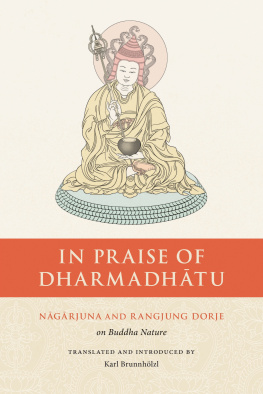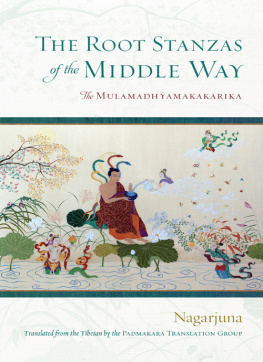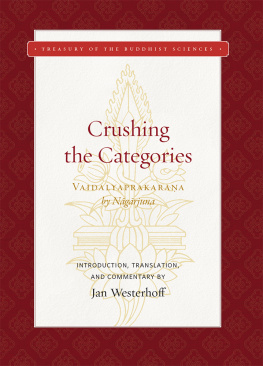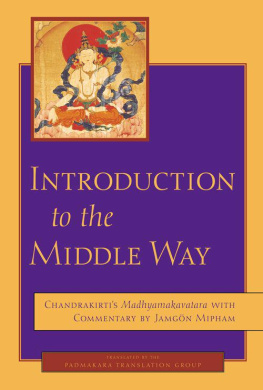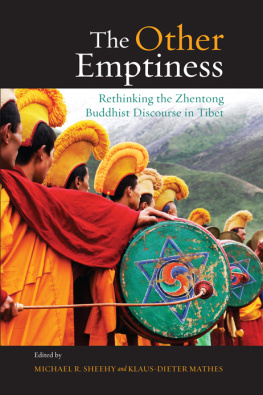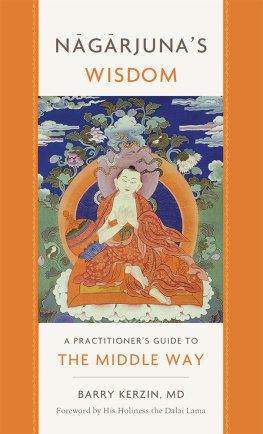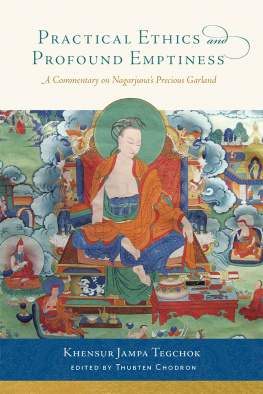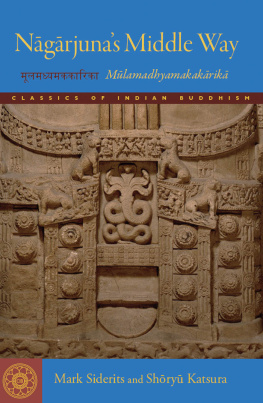Ngrjunas Madhyamaka
Ngrjunas Madhyamaka
A Philosophical Introduction
JAN WESTERHOFF


Oxford University Press, Inc., publishes works that further
Oxford Universitys objective of excellence
in research, scholarship, and education.
Oxford New York
Auckland Cape Town Dar es Salaam Hong Kong Karachi
Kuala Lumpur Madrid Melbourne Mexico City Nairobi
New Delhi Shanghai Taipei Toronto
With offices in
Argentina Austria Brazil Chile Czech Republic France Greece
Guatemala Hungary Italy Japan Poland Portugal Singapore
South Korea Switzerland Thailand Turkey Ukraine Vietnam
Copyright 2009 by Oxford University Press, Inc.
Published by Oxford University Press, Inc.
198 Madison Avenue, New York, New York 10016
www.oup.com
Oxford is a registered trademark of Oxford University Press
All rights reserved. No part of this publication may be reproduced,
stored in a retrieval system, or transmitted, in any form or by any means,
electronic, mechanical, photocopying, recording, or otherwise,
without the prior permission of Oxford University Press.
Library of Congress Cataloging-in-Publication Data
Westerhoff, Jan.
Nagarjunas Madhyamaka: a philosophical introduction / Jan Westerhoff.
p. cm.
Includes bibliographical references.
ISBN 978-0-19-537521-3; 978-0-19-538496-3 (pbk.)
1. Nagarjuna, 2nd cent. 2. Madhyamika (Buddhism) I. Title.
BQ7479.8.N347W48 2008
294.392092dc22 2008024577
9 8 7 6 5 4 3 2 1
Printed in the United States of America
on acid-free paper
to
DSR
Dont you mind dying, sir? the consul asked. Forgive me a little lofty talk, van Gulik said, but all movement is illusory. From Seoul to Kobe. From life to death.
Janwillem van de Wetering, Robert van Gulik: His Life, His Work
Acknowledgments
This book owes many different things to many different people. My greatest debt of gratitude is to David Seyfort Ruegg, who spent many hours with me talking through various incarnations of these pages and generously shared his encyclopedic knowledge of the Indian and Tibetan philosophical traditions. Ulrich Pagel provided invaluable support in academic as well as in administrative matters.
On the linguistic side I have to thank Alexandra Leduc for organizing a splendid Sanskrit-Tibetan translation seminar in London (despite only narrowly avoiding appeal to the rule tres faciunt collegium), as well as Ulrike Roesler for attempting to arrange something similar at Oxford. Mattia Salvini acted as a guide to the perplexed concerning various points of Sanskrit grammar and, apart from being an excellent Sanskritist, showed himself to be a similarly excellent thinker and provided me with many very useful suggestions for understanding Ngrjunas arguments. Geshe Sherab Gyatso kindly offered his help in trying to make sense of a rather terse passage in a Tibetan commentary on Ngrjuna.
Jay Garfield and Tom Tillemans read through previous versions of this material and made many useful suggestions which helped me to improve the discussion considerably. Ralf Kramer, former Tibetan librarian at the Indian Institute in Oxford, tracked down the most obscure texts in the shortest possible time and gave me countless fascinating Tibetological references. Support in various forms was provided by the Spalding Trust, the Society for South Asian Studies, and the Deutsche Forschungsgemeinschaft and is gratefully acknowledged.
Finally, thanks are due to Yuka Kobayashi for keeping the sun shining.
J.C.W.
New York City
First day of the Male Earth
Rat Year of the 17th Cycle
Contents
Abbreviations
References to works in verse give the number of the chapter and verse or half-verse (e.g., MMK 24:18, R 1:49a), apart from works not usually subdivided into chapters, such as the YS, S, VV, and VP, where only the number of the verse is given. References to works in prose give the page and line of the editions cited below (e.g. VV(S) 82:37).
WORKS BY NGRJUNA
MMK Mlamadhyamakakrik
J.W. De Jong, Christian Lindtner (eds.), Ngrjunas Mlamadhyamakakrik Praj Nma. Adyar Library, Adyar, Chennai, 2004.
YS Yuktisastik
Cristina Anna Scherrer-Schaub: Yuktisastikvrtti: Commentaire la soixantaine sur le raisonnement, ou, du vrai enseignement de la causalit. Institut belge des hautes tudes chinoises, Brussels, 1991.
S nyatsaptati
The nyatsaptati of Fernando Tola and Carmen Dragonetti, On Voidness. A Study of Buddhist Nihilism, Motilal Banarsidass, Delhi, 2002, 5399.
VV Vigrahavyvartan
VV(S) Svavrtti on the Vigrahavyvartan
Kamaleswar Bhattacharya, E. H. Johnston, and Arnold Kunst (eds.), The Dialectical Method of Ngrjuna. Motilal Banarsidass, Delhi, 1998.
VP Vaidalyaprakarana
VP(S) Svavrti on the Vaidalyaprakarana
Fernando Tola and Carmen Dragonetti, Ngrjunas Refutation of Logic. Motilal Banarsidass, Delhi, 1995.
R Ratnval
Michael Hahn: Ngrjunas Ratnval. The Basic Texts (Sanskrit, Tibetan, Chinese). Indica et Tibetica, Bonn, 1982.
WORKS BY OTHER AUTHORS
PP Candrakrtis Prasannapad
Louis de la Valle Poussin (ed.), Prasannapad Mlamadhyamakavrttih. Bibliotheca Buddhica IV, St Petersburg, 19031913.
J. W. De Jong: Textcritical notes on the Prasannapad, Indo-Iranian Journal 20, 1978, 2559, 217252. (Corrections of the above edition.)
MA Candrakrtis Madhyamakvatra
MAB Candrakrtis Madhyamakvatrabhsya
Louis de la Valle Poussin (ed.), Madhyamakvatra par Candrakrti Bibliotheca Buddhica IX, St. Petersburg, 19071912.
C ryadevas Catuhataka
Karen Lang (ed.), ryadevas Catuhataka. On the Bodhisattvas Cultivation of Merit and Knowledge. Akademisk Forlag, Copenhagen, 1986.
BCA ntidevas Bodhicaryvatra
Louis de la Valle Poussin (ed.), Bodhicaryvatra of ntideva, Asiatic Society of Bengal, Calcutta, 1907.
NS Nyyastra
Taranatha Nyaya-Tarkatirtha and Amarendramohan Tarkatirtha (eds.), Nyyadaranam with Vtsyyanas Bhsya, Uddyotakaras Vrtika, Vcaspati Miras Ttparyatk and Vivanthas Vrtti, Munshiram Manoharlal, Delhi, 1985.
Ngrjunas Madhyamaka
1
Introduction
The following pages contain an investigation of Ngrjunas philosophy from a systematic perspective. Considering Ngrjunas important place in Buddhist philosophy as well as in Indian thought more generally, it is not surprising that his works have given rise to an enormous number of commentaries, studies, and analyses in Asia, and, more recently, also in the West. A large amount of these take the form of commentaries on specific texts, following their structure and analyzing individual passages in considerable detail. While the importance and usefulness of such commentaries is beyond dispute, the present work sets out to approach Ngrjunas philosophy from a different perspective. The idea is to present a synoptic overview of Ngrjunas arguments concerning different philosophical problems in order to present an account of the whole of his philosophy, showing how its individual parts fit together as elements of a single philosophical project. In order to achieve this goal, it is not sufficient to give a mere paraphrase of Ngrjunas arguments (as is frequently found in the secondary literature). We will have to analyze their philosophical contents, examine actual as well as possible objections, determine whether the arguments can in fact be made to work, and, if so, what kind of philosophical conclusion they support. Comparatively little work has been done in this direction. Since a great part of the contemporary Western studies of Ngrjuna are interested primarily in philological, historical, or religious aspects of his works, genuinely philosophical studies have been rare. The aim of the present study is to help close this gap.
Next page

